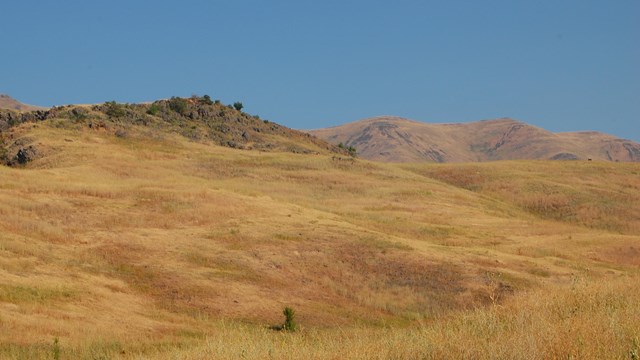
NPS Image. Nestled among the wheat fields of the Camas Prairie in Idaho is a shallow, natural body of water covering about 36 acres known today as Tolo Lake. While locals often visit this small, quiet pond to fish or watch migratory birds, the lake is best understood as a time capsule with a rich and varied history. Mammoth DiscoveriesThe 36-acre Tolo Lake is an affiliated site of the Nez Perce National Historical Park that is owned and managed by the Idaho State Fish and Game (IDF&G). In September 1994 IDF&G cooperated with The Friends of Tolo Lake to improve fish and wildlife habitat when a worker saw something in the muck—a huge bone! Authorities identified it as a Columbian Mammoth. A hasty two-week paleontological recovery of prehistoric mammoth and bison ensued. Work resumed in August 1995, resulting in recovery of three mammoth skeletons and an ancient bison skull. Other fossils were left in place as a preservation measure. Mammoths became extinct around 12,500 years ago. The Columbian Mammoth (Mammuthus columbi) stood 13 feet at the shoulder and weighed up to ten tons. They were similar to modern African Elephants. Like elephants, Mammoths were herbivores whose family groups tended to move in herds. The largest tusks found measured 16 feet. There is some debate over how much hair the Columbian Mammoth would have had. Some scientists think they were not as furry as wooly mammoths and may have had only tufts of hair on their head and along their back. TepahlewamTepahlewam is a nimíipuu (Nez Perce) word that means Split Rocks, referring to Rocky Canyon west of the lake. This lake is an ancient rendezvous site that many bands of the nimíipuu used for gathering foods such as camas root and for meetings with neighboring bands. The canyon was part of a transportation network in the area, connecting with the Salmon River and Snake River drainages. Tolo Lake during the Nez Perce Flight of 1877By June 2, 1877, at least 600 nimíipuu from several 'non-treaty' bands, including Chief Joseph's band, gathered at Tolo Lake. They were sorrowfully complying with the U.S. government's demand to leave their traditional homelands and resettle on the smaller Nez Perce Reservation near Lapwai. This demand stung—the reservation was a tenth of that guaranteed by the Treaty of 1855, now reduced by the “Thief Treaty” of 1863, which these bands had never signed. Emotions ran high as the people's last few days of true freedom came to an end. On the night of June 13, three young warriors from White Bird's band, Wáalaytic (Shore Crossing), Sáapsis ’ilp’ílp (Red Mocassin Tops) and Wetyétmes wehéyqt (Swan Necklace), incensed by past injustices at the hands of white settlers, left the encampment in search of Larry Ott, who had killed one of their fathers a few years earlier. Unable to find him, they raided other settlements instead, killing a number of people. Several more warriors joined them on June 14, and by the end of the day they had slain 15 settlers. Fear gripped both settlers and the rest of the nimíipuu on the Salmon River and Camas Prairie. The chiefs were in council when they heard about the raids on the Salmon River settlers. Fearing retribution, the council ended abruptly as people and stock were gathered to depart to a safer place to await the coming U.S. Army. Learn more about what happened next by following the links below. 
White Bird Battlefield History
During the first battle of the Nez Perce War on June 17,1877, the Nez Perce defeated the U.S. cavalry and escaped to find safety. 
The Nez Perce Flight of 1877
In 1877, the non-treaty Nez Perce were forced on a 126-day journey that spanned over 1,170 miles and through four different states. ToloThe lake was named after a nimíipuu woman who brought news of the attacks on settlers to miners in Florence. Known as Tulekats Chikchamit, her nimíipuu name was corrupted to “Tule” and then “Tolo” by non-Indians. In gratitude for her courage and loyalty, she was the only nimíipuu given an allotment outside the reservation. She died in 1920, and is buried in Winona, Idaho. Nez Perce Trail Auto TourThe staff at the Nez Perce National Historic Trail have developed auto tours with travel instructions for retracing the 1877 route of the Nez Perce along with maps, graphics, and details about the confilct at sites you can see along the way. Download Auto Tour 1 for more details about the what occurred at Tolo Lake and other early events in the Nez Perce Flight of 1877. 
Visit Tolo Lake
Plan your trip to Tolo Lake, located near Grangeville, ID. |
Last updated: December 29, 2022
